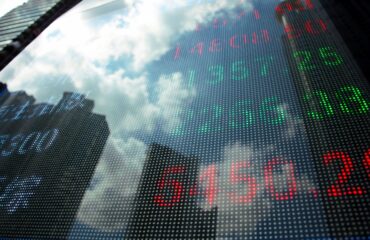The stock market, a collective human enterprise, so often reveals a potent irony that could bemuse even Sophocles. This week, as the tech giants returned to prominence with a youthful skip in their step, the S&P 500, the broad market’s trusty yardstick, nudged its snout ever so gently into the coveted territory of the bull market.
In this expansive financial landscape, the technology shares are mounting a noticeable renaissance, seemingly undeterred by the Federal Reserve’s tightening tendencies. Tesla, the poster child of corporate ambition, found its stock price elevated by over 4%, following the news of General Motors hitching a ride on Tesla’s expansive charging network. The economic ecosystem continues to evolve in fascinating ways.
But the tech industry’s influence wasn’t confined to the electric automotive scene. Netflix, the omnipresent giant of the streaming world, saw a 2.6% rise after a reported influx of US subscribers in the wake of a crackdown on password sharing. And then there was Adobe, basking in the artificial intelligence sun, its shares advancing by 3.4%. This was the market’s response to our world inching ever closer to the future, with artificial intelligence becoming less of a buzzword and more of a reality.
However, some whispers of caution are meandering through the financial corridors, suggesting that this rally may encounter a bump in the road ahead. The Federal Reserve and the European Central Bank are gearing up for their respective interest-rate decisions next week, their announcement akin to the tolling bells that could mark a shift in the market’s rhythm.
With the unexpected rate hikes from two central banks earlier this week, speculation mounts that policymakers may need to keep their interest rate shields held high for a longer period. These developments, combined with a shift in the American labor market’s temperature dial towards the cooler end, seem to support the consensus view that the Federal Reserve is inching closer to a pause.
Intriguingly, the financial players’ response to the tech rally isn’t entirely exuberant. Stuart Kaiser, head of US equity trading strategy at Citigroup, confessed a certain discomfort with the tech trade’s direction. He highlighted a scarcity of growth in the market, a factor that appears to be driving investors to pay a premium for companies that can showcase it. But the challenge, as he sees it, is converting this rally into something more durable and sustainable.
Similarly, Solita Marcelli of UBS Global Wealth Management urged a cautious approach towards the recent equity upswing. She voiced the possibility that this could be a bear market rally – a period of robust gains within the context of a bear market. Until markets surge to a new all-time high, she argues, it’s challenging to ascertain whether the bear market trough, the lowest point of the market cycle, is truly behind us.
Elsewhere, Canada’s employment data unveiled a mild hiccup in the labor market, putting an end to eight months of continued job gains. This new development has pushed Treasury yields higher. Meanwhile, swap traders are busy calculating the odds of a Fed hike next week, and currently, their crystal balls are indicating a one-third chance.
Over in the old continent, European stocks slipped after a pessimistic outlook from Croda International Plc cast a long shadow over chemical shares. But the Japanese Nikkei 225, the Land of the Rising Sun’s proud market index, celebrated a ninth week of gains – its longest streak in over five years. As an indicator of global sentiments, these occurrences remind us of the constant dance of financial fortunes across various sectors and geographies.
In the world of currencies,
The stock market, a collective human enterprise, so often reveals a potent irony that could bemuse even Sophocles. This week, as the tech giants returned to prominence with a youthful skip in their step, the S&P 500, the broad market’s trusty yardstick, nudged its snout ever so gently into the coveted territory of the bull market.
In this expansive financial landscape, the technology shares are mounting a noticeable renaissance, seemingly undeterred by the Federal Reserve’s tightening tendencies. Tesla, the poster child of corporate ambition, found its stock price elevated by over 4%, following the news of General Motors hitching a ride on Tesla’s expansive charging network. The economic ecosystem continues to evolve in fascinating ways.
But the tech industry’s influence wasn’t confined to the electric automotive scene. Netflix, the omnipresent giant of the streaming world, saw a 2.6% rise after a reported influx of US subscribers in the wake of a crackdown on password sharing. And then there was Adobe, basking in the artificial intelligence sun, its shares advancing by 3.4%. This was the market’s response to our world inching ever closer to the future, with artificial intelligence becoming less of a buzzword and more of a reality.
However, some whispers of caution are meandering through the financial corridors, suggesting that this rally may encounter a bump in the road ahead. The Federal Reserve and the European Central Bank are gearing up for their respective interest-rate decisions next week, their announcement akin to the tolling bells that could mark a shift in the market’s rhythm.
With the unexpected rate hikes from two central banks earlier this week, speculation mounts that policymakers may need to keep their interest rate shields held high for a longer period. These developments, combined with a shift in the American labor market’s temperature dial towards the cooler end, seem to support the consensus view that the Federal Reserve is inching closer to a pause.
Intriguingly, the financial players’ response to the tech rally isn’t entirely exuberant. Stuart Kaiser, head of US equity trading strategy at Citigroup, confessed a certain discomfort with the tech trade’s direction. He highlighted a scarcity of growth in the market, a factor that appears to be driving investors to pay a premium for companies that can showcase it. But the challenge, as he sees it, is converting this rally into something more durable and sustainable.
Similarly, Solita Marcelli of UBS Global Wealth Management urged a cautious approach towards the recent equity upswing. She voiced the possibility that this could be a bear market rally – a period of robust gains within the context of a bear market. Until markets surge to a new all-time high, she argues, it’s challenging to ascertain whether the bear market trough, the lowest point of the market cycle, is truly behind us.
Elsewhere, Canada’s employment data unveiled a mild hiccup in the labor market, putting an end to eight months of continued job gains. This new development has pushed Treasury yields higher. Meanwhile, swap traders are busy calculating the odds of a Fed hike next week, and currently, their crystal balls are indicating a one-third chance.
Over in the old continent, European stocks slipped after a pessimistic outlook from Croda International Plc cast a long shadow over chemical shares. But the Japanese Nikkei 225, the Land of the Rising Sun’s proud market index, celebrated a ninth week of gains – its longest streak in over five years. As an indicator of global sentiments, these occurrences remind us of the constant dance of financial fortunes across various sectors and geographies.



